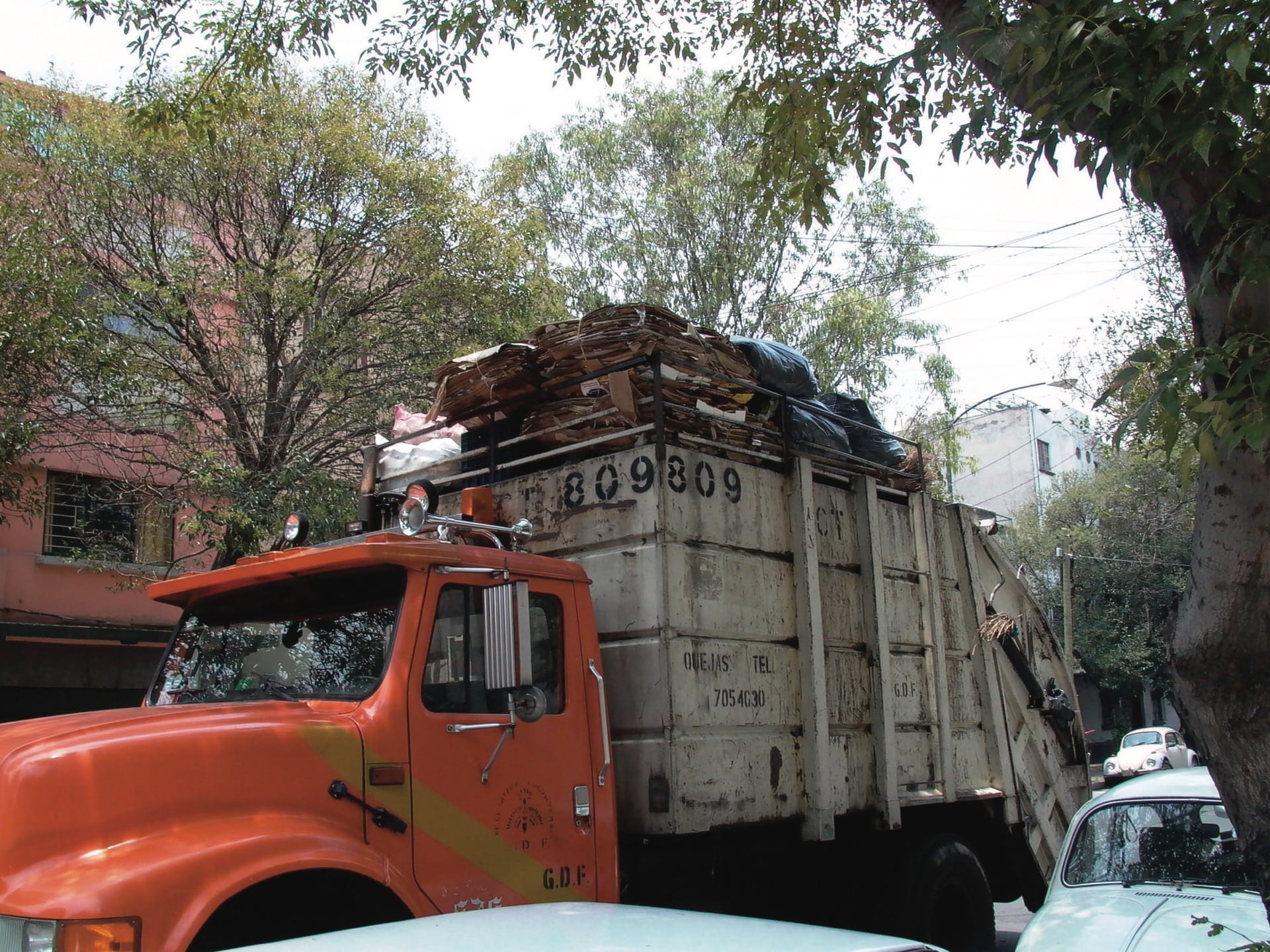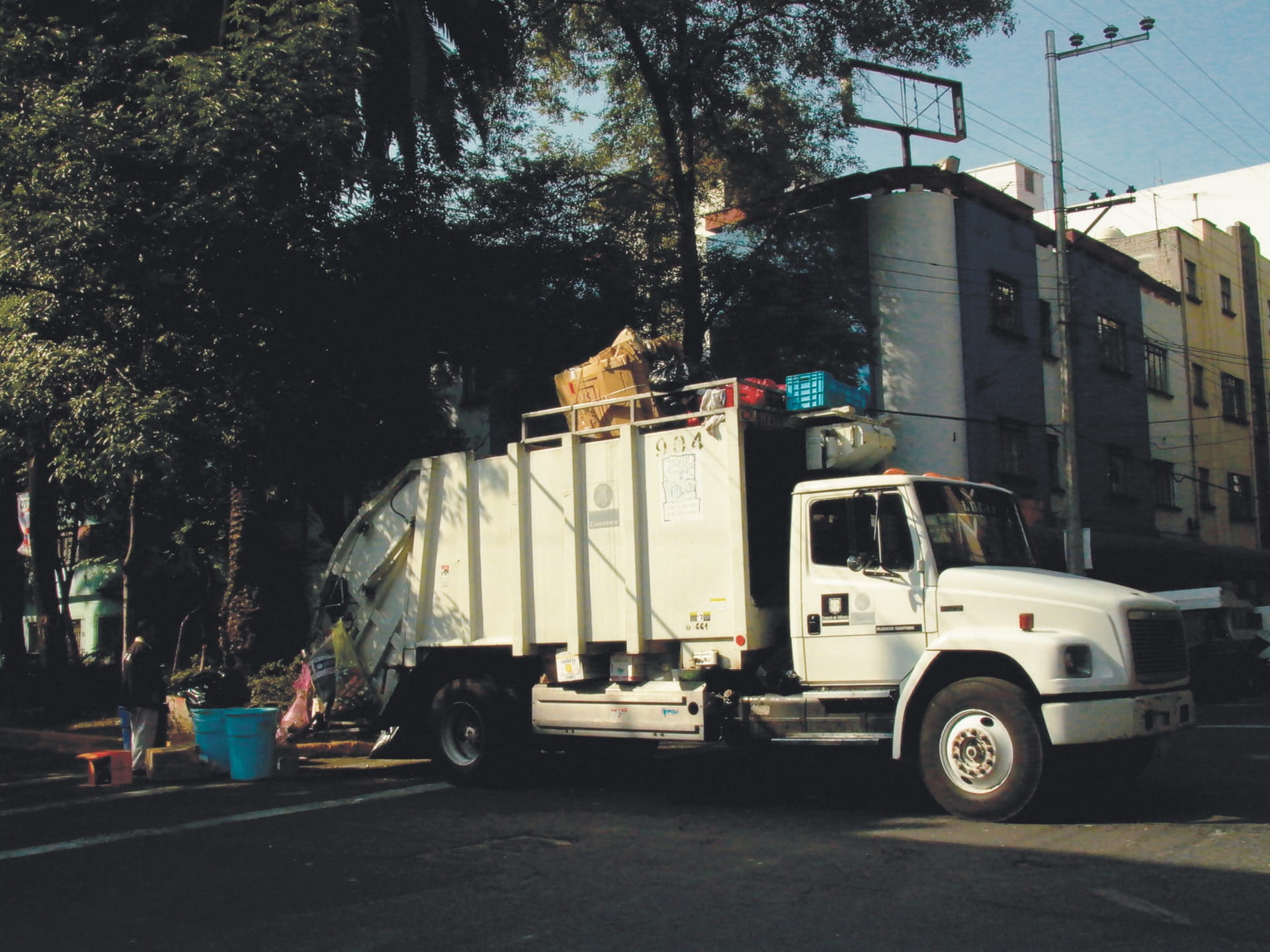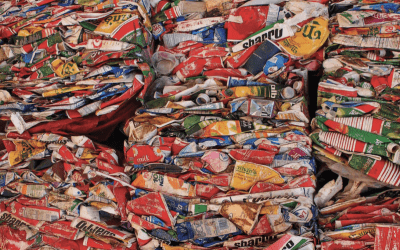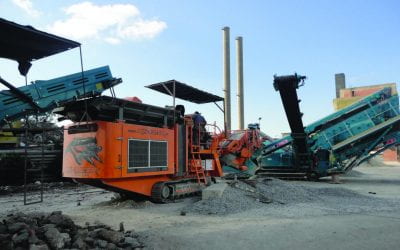Privatizing Latin American Garbage? It’s Complicated…
A View from the Northern Border of Latin America

A garbage truck in Mexico City, 2003, has been reconfigured to do more than merely collect trash quickly. Workers made the trucks suitable for sorting and siphoning materials for resale. Photo by Sarah Hill.
In the early 1970s, a plucky group of 200+ pepenadores (scavengers) in Ciudad Juárez, Mexico, secured a 25-year concession to recover recyclable materials deposited in that city’s dump, along with the right of first refusal on a second 25-year contract.
And so began a celebrated chapter in the long saga of Socosema, one of Mexico’s most—for a time—successful worker-owned recycling cooperatives. And, as well, so marked another chapter in a long-standing tension in Mexico between “public” and “private” management of waste.
In the years that followed, illiterate cooperative members left their old cardboard hovels on the dump for houses made of conventional building materials. They sent their children to school. They got inoculations, treated their wounds and illnesses and saved for retirement.
And as their enterprise grew, they invested in it, purchasing tools, trucks, machinery and a small warehouse. Their success generated international acclaim, and they welcomed visitors—and received foreign invitations—to explain their rags-to-riches transformation.
Key to that transformation was how they had persuaded Juárez city officials that the collective riches of garbage belonged in the hands of its workers, not in the hands of the businessman who had previously “owned” the dump.
But a little more than two decades later the cooperative unraveled when Juárez closed its long-serving dump (called, in the border argot of English borrowings, “el dompe”) and opened, five miles distant, a new, technically engineered and federally permitted sanitary landfill.
The new landfill lay far away from the scavengers’ settlement and was launched under management contract to a subsidiary of a multinational waste firm. Cooperative rolls fell off sharply as members decried this development and speculated that the waste management giant aspired to secure the pending recyclables contract.
PUBLIC OR PRIVATE?
This snapshot of Juárez’s dump story over a quarter century pokes some holes in easy categorizations of waste management as trending toward, or away from, privatization in Latin America. Indeed, unlike other public services that have shifted from well-defined public ownership to wholly private hands (such as telephone and airlines in some Latin American countries), waste management has often defied the neat boundary between public and private, even in the contemporary era, when the ideological dominance of privatization suggests that the management of waste should be the business of business, not governments.
Any observer in the region might note garbage trucks trundling down city streets emblazoned with the logos of multinational firms (as in Colombia, Brazil and Cuba, for example). Nonetheless, a closer look at both the history of sanitation and present developments challenges axiomatic claims that waste management has been a largely public service to date (and that moving it to the “private” column is a good thing).
The porous boundary between public and private in waste management begins with the nature of garbage itself: individuals generate unwanted stuff, but that stuff only becomes garbage when it finds its way—unwanted—into the public domain, where it becomes in essence a collective problem.
Waste management is hardly new in Latin America. Pre-conquest Mayan cities, for example, had formal waste repositories. And in the enormous Tenochtitlán, up to 1,000 low-caste workers kept that city’s streets clean under Aztec waste management.
In the colonial era, Mexican authorities promulgated sanitary laws, creating some of the first known legal frameworks for waste management. These laws explicitly acknowledged the private origins of noxious and unsanitary stuff, while tacitly acknowledging the crown’s duty to control that stuff.
Nonetheless, the sanitary laws converted that duty into private burdens by dictating what could and could not be done with household output. And they established contracts with a private concessionaire who employed crown-owned carts and crown-enslaved natives to sweep the streets.
Should we call the ancient arrangements public or private? And do colonial laws mark the beginning of public or private control of waste management in Latin America?
The picture gets no clearer in the early 20th century, the era of municipal reform in the United States and Canada, when most large cities there brought street sweeping and garbage collection under municipal command and control. They did so for explicitly sanitary purposes: to clean cities more effectively and completely of refuse that threatened public health.
While many Latin American cities continued to advance the legal framework shaping private practices of household effluvia and stuff, only the very large ones (for example, Bogota, Mexico City, and Rio among others) appear to have offered what their U.S. counterparts did: a definitively public service in a vertically integrated system that from start to finish was wholly owned and operated by a government entity (municipally owned vehicles or equipment run by municipal employees, and a municipally owned site of disposition).
But those cities that did launch public collection services saw them nibbled away by private and informal arrangements (e.g., sweepers who worked for neighborhoods; materials-buyers who paid households for valuable trash) which not only moved a lot of garbage by other-than-public hands; they also ate up a lot of the garbage before it ever made its way to a dumpsite.
MEXICO CITY: A HYBRID “SYSTEM”
Let’s take a closer look at the dynamics of trash in Mexico City: its public-sector union of garbage collectors dates back to 1934, a history that echoes similar public service arrangements in the United States, Canada and various European systems of the time.
But throughout the 20th century, the vehicles and the collection practices of these public workers bore little resemblance to their foreign counterparts. Whereas U.S. municipal sanitation workers worked to clean streets and curbs of garbage, Mexican municipal sanitation workers sought to harvest resources in garbage. Accordingly, Mexico City sanitation workers modified their trucks so that they could perform a dual duty of transporting both waste and sorted recyclables. In that way, poorly paid city staff supplemented their city salaries by exploiting their public charge for private profit.
Trash day in prosperous neighborhoods unfolded like this (a scene I first witnessed in the 1990s): drivers parked their trucks for no less than 30 minutes on quiet side streets while workers—some paid and others “volunteering”—scurried between apartment buildings to collect waste, typically conveyed, gooey and wet, in plastic grocery bags.
The workers broke these bags open on the sidewalks to mine for usable or marketable items. Valuable materials then went into separate bags—one each for plastics, metals, glass, and other substances—that dangled like ornaments from hooks welded to the sides of trucks. Cardboard got flattened and stacked to fit into ingenious topside cradles.
While the law in Mexico City had long established garbage collection as a free public service, in practice residents paid fees (and still do) to get their stuff out of their households and into the hands of the collectors. These voluntary “tips” averaged 500 pesos a year in 1997 (or about USD $60). Even today, maids might also sweeten the pot a little by offering garbage collectors choice materials (or they might themselves glean from their employers’ trash).
On the trucks, a strict hierarchy established the rate of income that workers obtained from the recycling business (again, a supplement to their union-negotiated salaries). They called their routes fincas (plantations) and referred to their bosses as “owners” (not bosses) who harvested the lion’s share of income from collecting, sorting, and selling.
At the dumps, the public work of waste disposal further disintegrated in the hands of thousands of scavengers who combed for what the plantation owners (in the finca system) had overlooked, as well probed the garbage coming from sources other than municipal collection routes.
In his 1983 study of Mexico City’s garbage, sociologist Héctor Castillo Berthier described this feudal arrangement as embedded within Mexico’s corporatist structure. Like other corporatist entities, waste management conveyed market opportunities to party members by seamlessly blending public and private systems of power, reward and control.
In sum, 20th-century waste management in Mexico City, though operating under the framework of a public service, looked more like the system of private carting that had prevailed in U.S. cities before the advent of waste management as a public service.
WHAT’S THE PROBLEM?
What are the advantages and disadvantages here? Let’s step back and consider the historical objectives of public and private waste management systems. True public systems grew up in Europe and north of the U.S.-Mexico border at the beginning of the 20th century, when municipal sanitarians began to understand the relationship between refuse and public health. So, these systems had (and still have) as their goal, the sanitary disposition of waste.
By contrast, until the mid 20th century, the private carting system in the United States primarily served to exploit garbage for its marketable resources. Carters collected garbage—typically for a fee from householders—in order to siphon off materials with market value. Thus, carters made their money primarily on the value of the contents of garbage, not on the service of waste removal. (My former in-laws in Parkersburg, West Virginia, for example, began their lard rendering business as pig farmers in the early 20th century, looking for slops).
And throughout the United States, cities like El Paso and New Orleans put waste removal in the hands of exclusive municipal “scavenging “ (i.e., not “waste removal”) contracts. By contrast, other cities, following the lead of New York, regarded sanitation as too vital to leave to contractors with any interest other than the public’s health.
By the third quarter of the 20th century, carters had became more like public-sector service providers, thanks to local ordinances that gradually imposed upon them the responsibility for safe and sanitary garbage removal (which in turn became their primary source of revenue). That shift stemmed from both the emergence of environmental laws, including a trinity of federal legislation in the 1970s (the Resource Conservation and Recovery Act, the Clean Air Act and the Clean Water Act), and fundamental changes in the markets for salvaged stuff.
The City of San Francisco provides an emblematic case of how carters transitioned from exploiting waste for its resources to managing waste to minimize its dangers. The sequence of name changes for the city’s primary private provider reflects that shift: from “Sunset Scavengers” at the turn of the 20th century, to the “Sanitary Fill Company,” to “Norcal Disposal,” to most recently, “Recology SF” (this last reflecting the return in the industry to a business model that combines disposal with resource-recovery).
Arguably, however, in Mexico City that late 20th-century shift to a privatized service did not occur. And why should it? For the entire 20th century and now into the 21st, Mexico City’s hybrid system has worked very efficiently (something that advocates of privatization value) at recovering valuable materials. Public-sector employees, eager for the supplemental income generated by diversion activities, have responded nimbly with entrepreneurial instincts to market signals.
Nonetheless, the World Bank, during the period when this system was most robust, urged Latin American city governments to “privatize” waste management.
For example, in an undated post on its website, under the heading of “Urban Solid Waste Management: Private Sector Involvement,” the bank explains its advocacy of the private sector: “[t]he private sector improves efficiency and lowers costs by introducing commercial principles such as limited and well-focused performance objectives, financial and managerial autonomy, a hard budget constraint, and clear accountability to both customers and providers of capital. The private sector plays other important roles by mobilizing needed investment funds, and by providing new ideas, technologies and skills.”
But, as the evidence from Mexico City suggests, its municipal public-ish system possesses many hallmarks of private enterprise: driver/managers work autonomously, maintain their own budgets and pay themselves not an hourly or salaried rate but according to the market value of collected goods, thereby incentivizing themselves to collect more and to collect it quickly.
So why would the bank advocate privatization for cities, such as Mexico, that already obtained some of the key attributes of privatization?
It did so because the goals of waste management in Latin America need to change. In short, Latin American municipal governments should now seek to protect the environment (and consequently human health) from garbage, rather than seek to exploit garbage for its resource potential.
According to other World Bank literature, Latin America generated close to 370,000 tons of garbage a day in 2007. But at best, less than 40 percent of that waste wound up in “environmentally sound” landfills (that is, landfills purpose built as such, lined to prevent ground water contamination, and plumbed to capture leachate and methane). And perhaps the percentage is even less, considering that Mexico—a country of 108,000,000 in 2007—counted only 11 such landfills in that year (including the one in Juárez).
Instead, most of this staggering volume of waste wound up in unlined, open-air dumps. True, such dumps, speckled with scavengers and informal waste sorters, no doubt recover more salvageable materials than gets diverted from the waste stream in the United States and Canada. But landfills outside of Latin America aim not to recover resources but to protect the environment.
To put the bank’s advocacy of privatization in a broader context: if Latin American countries adopt either European or U.S. standards of environmental protection, they will need to adopt the sanitary landfill and waste collection infrastructure that at this point, only very large, transnational waste management firms can provide.
No city anywhere in the United States or Canada (or in Europe, for that matter) builds its own trucks; no city designs its own landfills or incinerators; and few own all their transfer stations and other pieces of the vital waste management infrastructure. All of these services now come from industrial suppliers who make their profit on long-term, exclusive arrangements.
If Latin American cities do decide to change course in order to protect against garbage, rather than make the most of it, they will, inevitably embrace the kind of true privatization that may well put hybrid privatization out of business.
Still, at least one Latin American city, Brazil’s Curitaba, has experimented with developing its own indigenous waste management technology (you can read a detailed account of it in detail in a 2012 Huffington Post article by Roberta Brandes Gratz). But its homegrown ingenuity cannot extend beyond collection and sorting of mixed waste.
Ultimately, environmentally sound waste management in Curitaba will require a contract with a multinational waste giant. And this may provide a new future for Latin American waste management hybridism.
Winter 2015, Volume XIV, Number 2
Sarah Hill writes about Latin America, garbage and nature from Kalamazoo, Michigan, where she teaches anthropology and environmental studies at Western Michigan University.
Related Articles
Garbage: Editor’s Letter
Religion is a topic that’s been on my ReVista theme list for a very long time. It’s constantly made its way into other issues from Fiestas to Memory and Democracy to Natural Disasters. Religion permeates Latin America…
Buenos Aires, Wasteland
English + Español
Walking down Avenida Juan de Garay last week, I passed a giant black trash bag that had ballooned and burst. Orange peels, tomatoes, candy wrappers…
First Take: Waste
Waste—its generation, collection and disposal—is a major global challenge in the 21st century. Cities are responsible for managing municipal waste. Solid…





